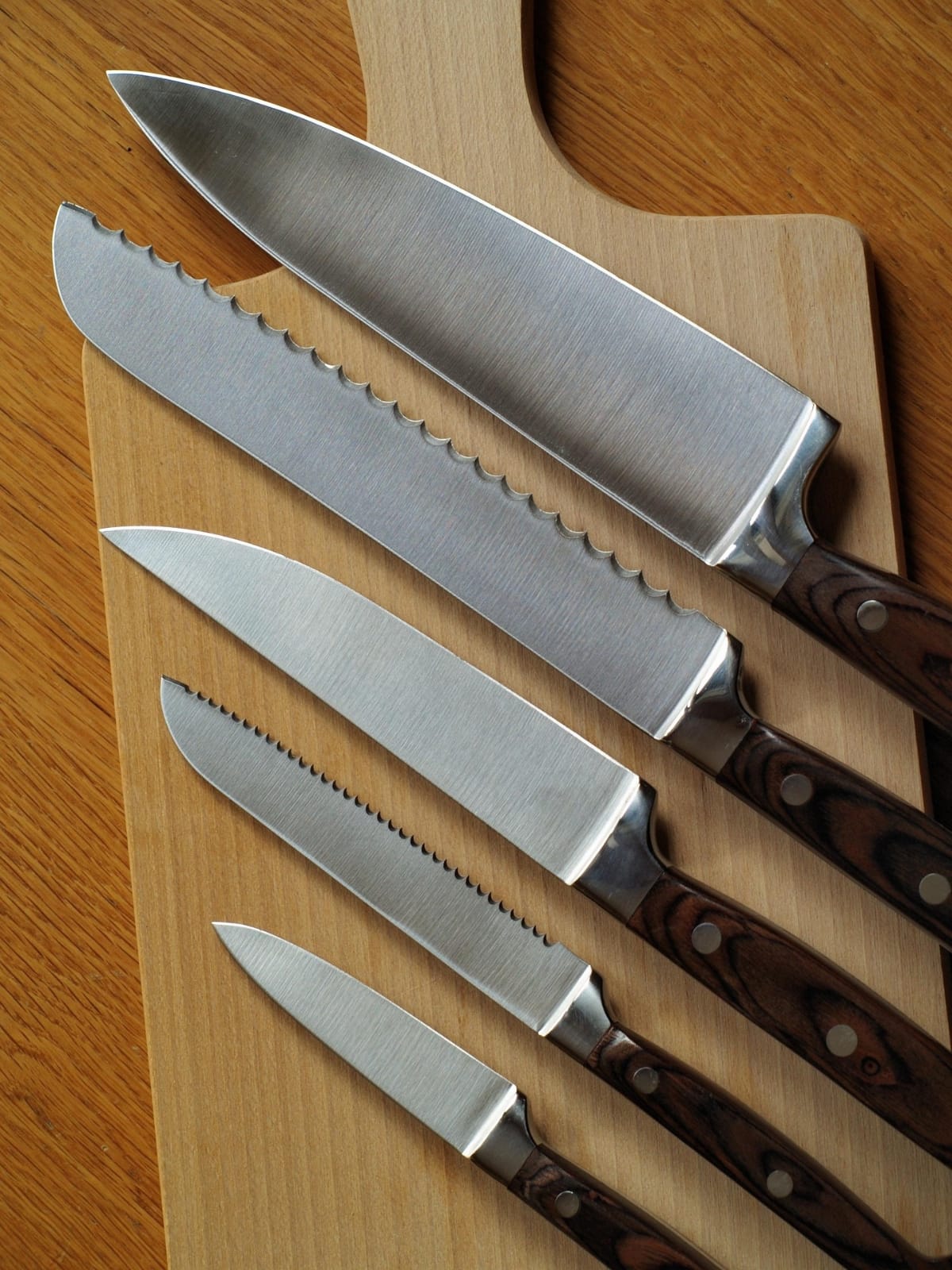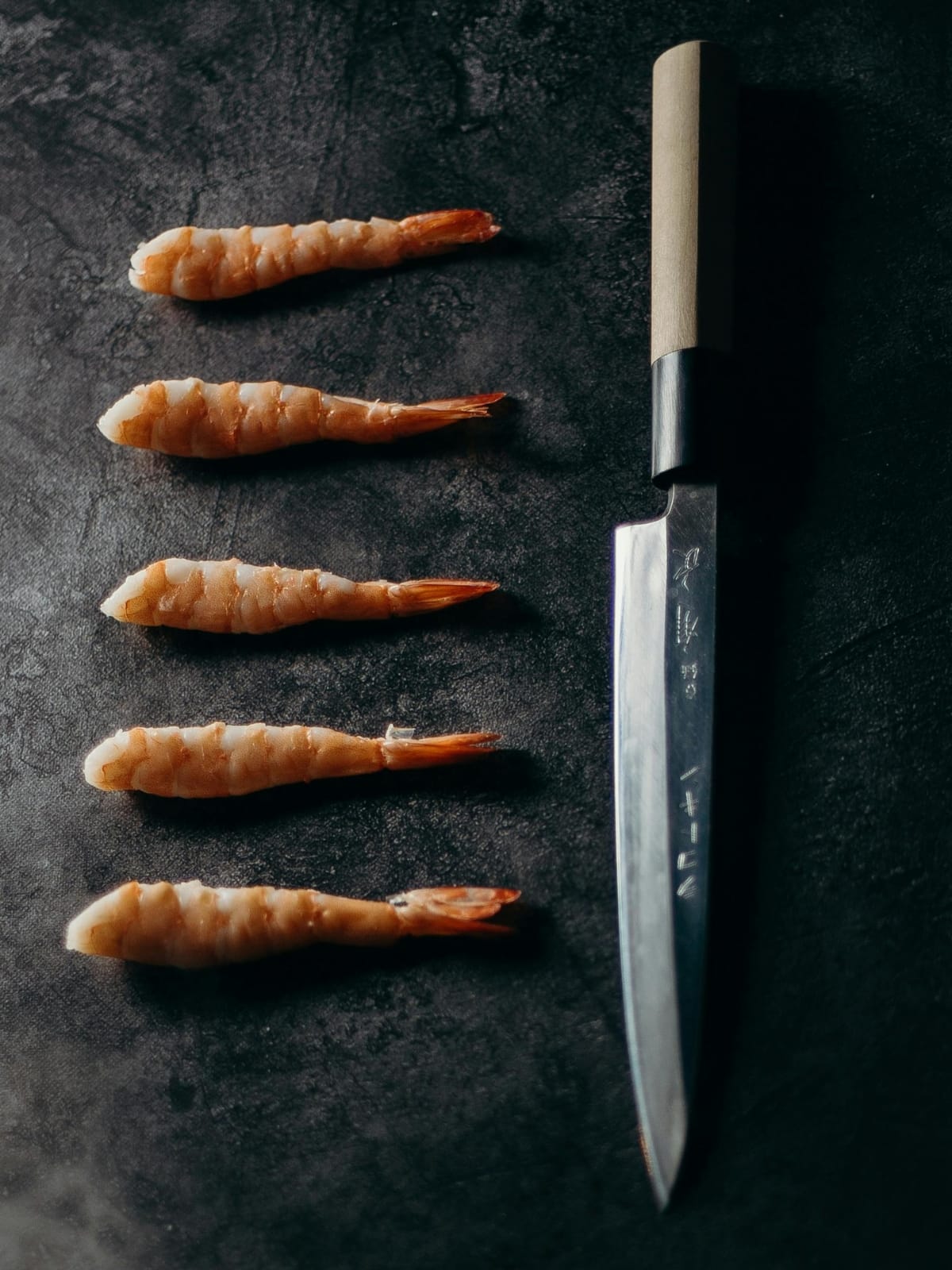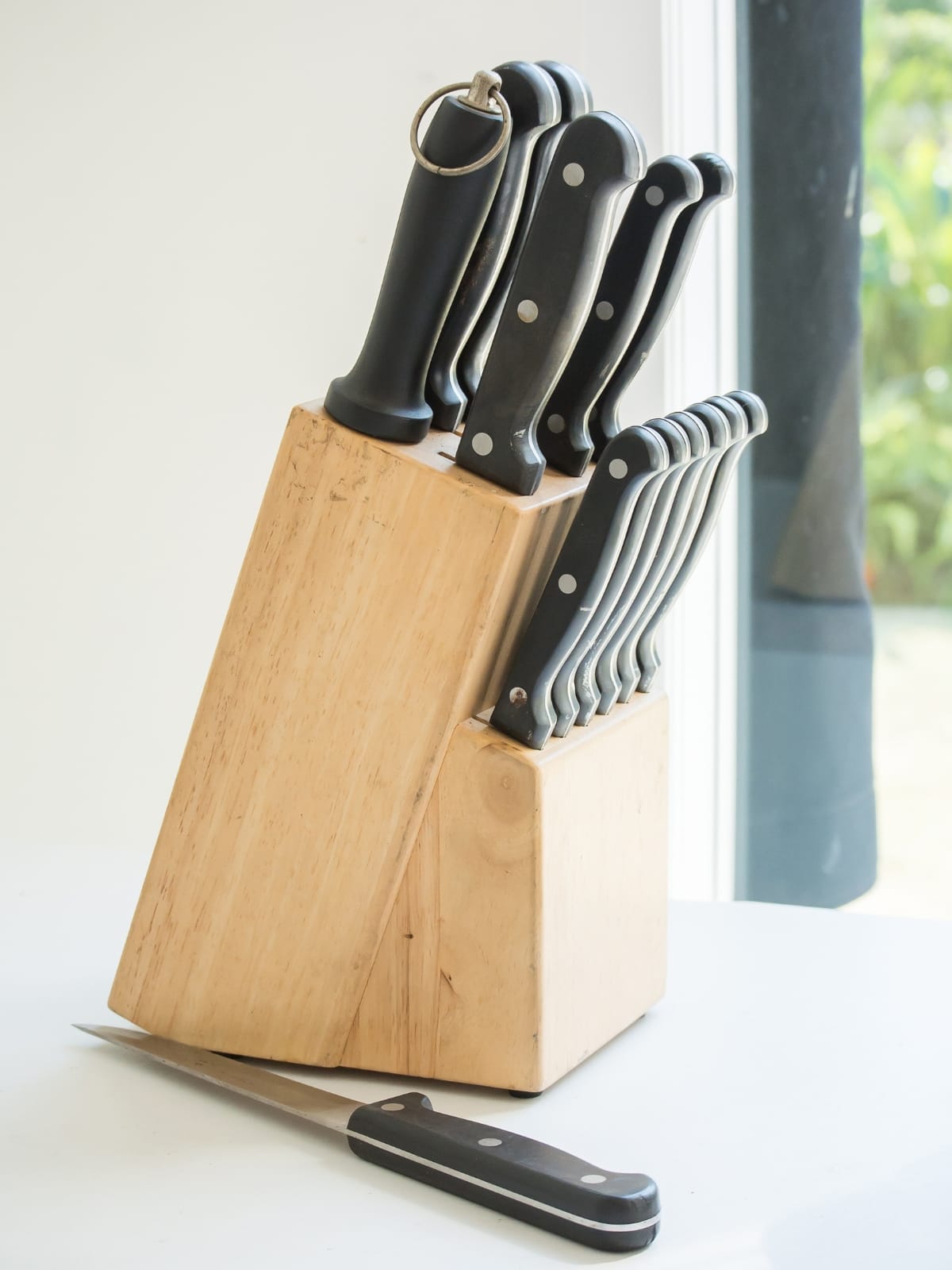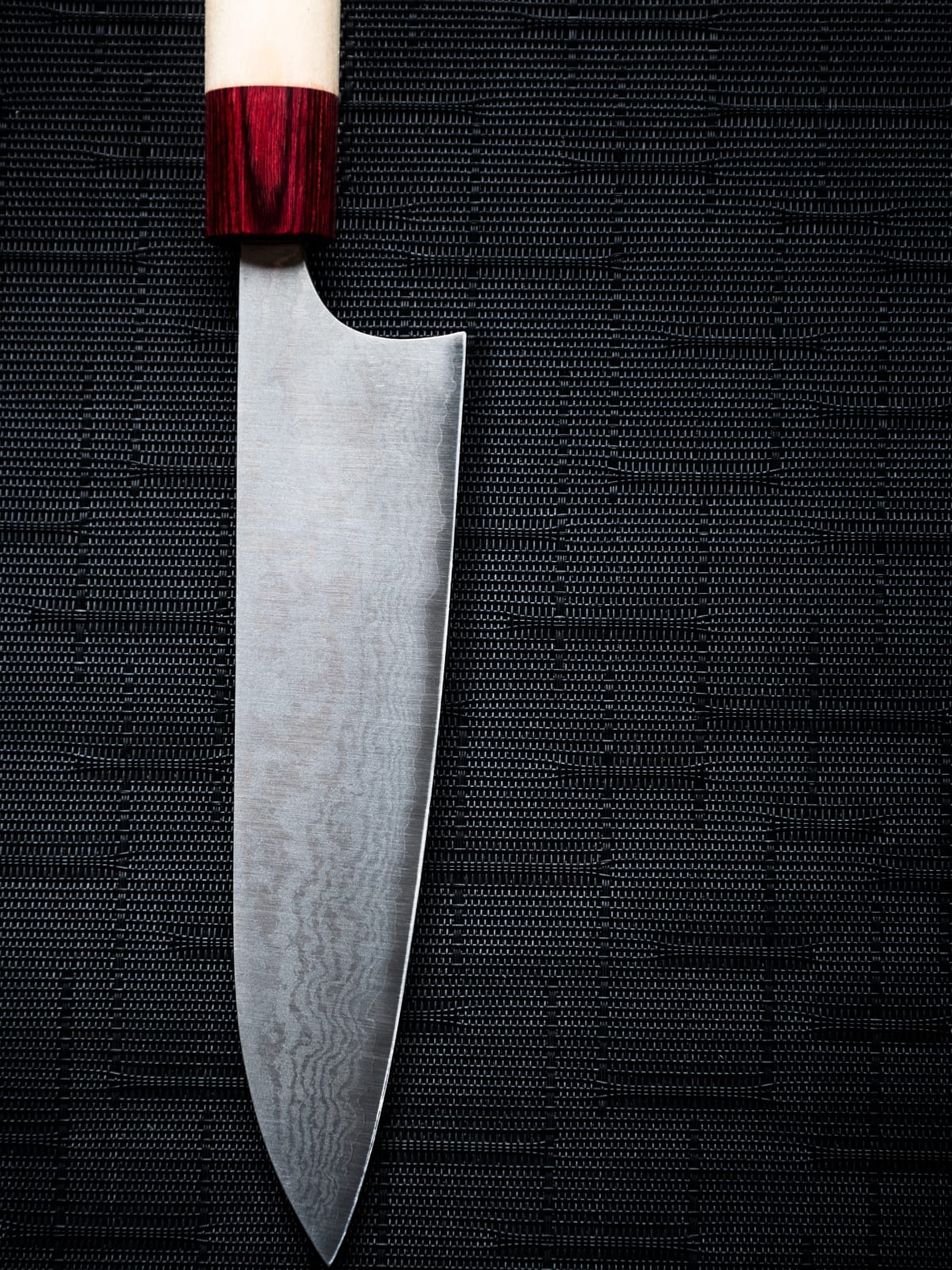As an experienced home cook, I’ve tested countless knives and understand the crucial role a quality chef’s knife plays in the kitchen. In this comprehensive review, we’ll explore the 10 best kitchen knives under $50 that offer professional-grade performance without breaking the bank. By comparing their key features, pros, and cons, I’ll help you find the perfect knife to elevate your culinary experience, whether you’re a beginner or a seasoned home chef.
The Importance of a Good Kitchen Knife
A quality kitchen knife is the cornerstone of efficient and enjoyable cooking. A sharp, well-balanced knife not only speeds up prep time and reduces the risk of accidents but also improves the quality of your cooking through clean, precise cuts. This leads to more even cooking and better presentation, as uniformly sliced ingredients cook at the same rate.
Moreover, using a high-quality knife transforms the cooking experience. The smooth action of a sharp blade gliding through ingredients turns mundane meal prep into a pleasurable process. It’s a satisfaction that’s hard to describe until you’ve experienced it firsthand, making the investment in a good kitchen knife well worth it for both beginner cooks and seasoned home chefs alike.
Gyuto vs Santoku Knives: Understanding the Differences
In our review, we’ll be looking at both gyuto and santoku knives. While both are versatile, all-purpose kitchen knives, they have some key differences that are worth understanding.
Gyuto Knives (Chef’s Knives)
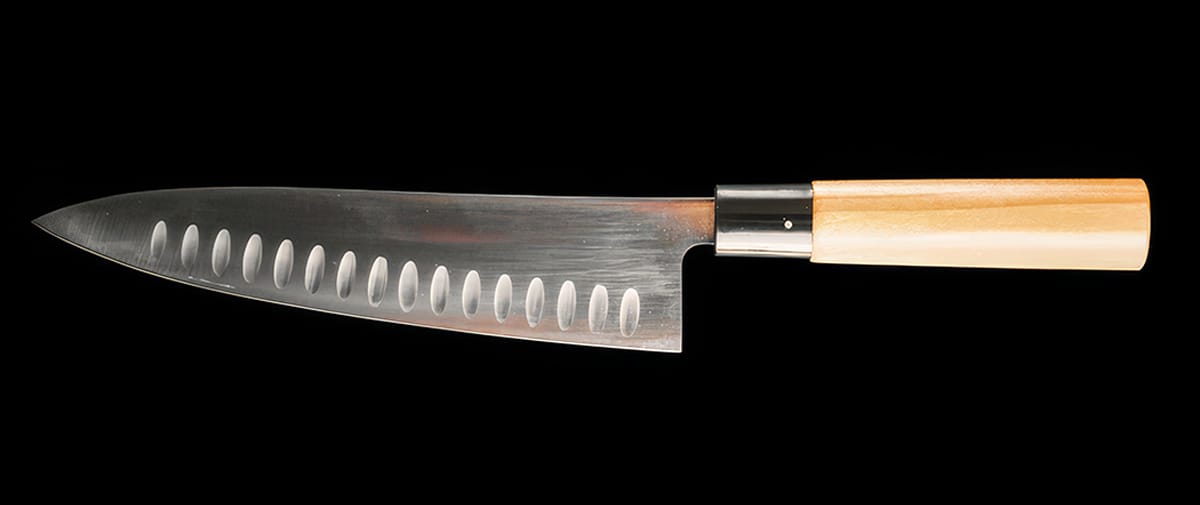
Gyuto knives, also known as Western-style chef’s knives, typically have the following characteristics:
- Longer blade, usually 8-10 inches
- Curved blade profile that allows for a rocking motion when chopping
- Pointed tip useful for precision tasks
- Versatile design suitable for a wide range of cutting tasks
I find gyuto knives particularly useful for tasks that require long, smooth cuts, like slicing large vegetables or carving meats. The curved blade allows for an efficient rocking motion when mincing herbs or garlic.
Santoku Knives (All-purpose Knives)
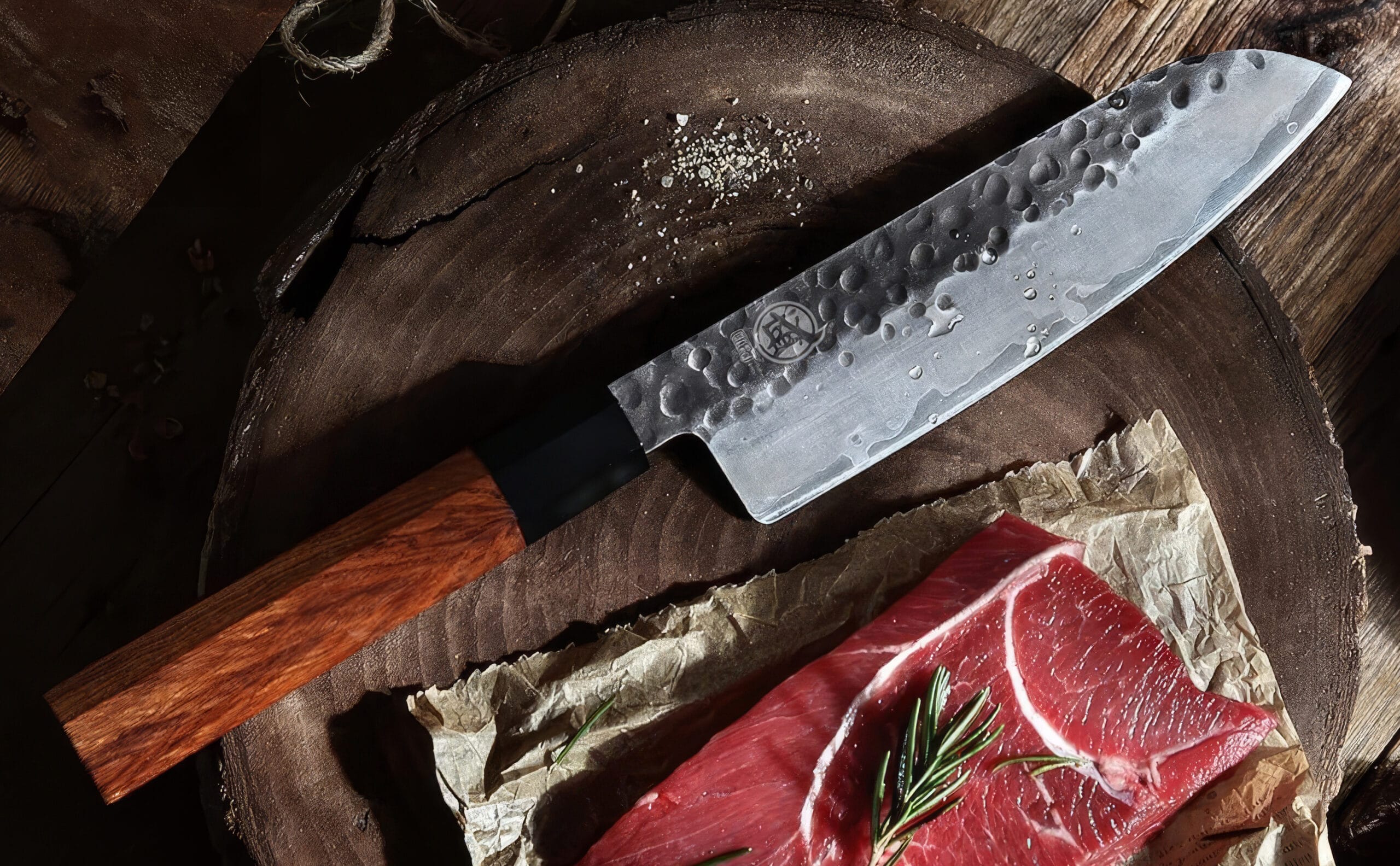
Santoku knives, which originated in Japan, have these distinctive features:
- Shorter, wider blade, usually 5-8 inches
- Flatter edge profile, better suited for up-and-down chopping motions
- “Sheepsfoot” blade with a less pointed tip
- Often feature dimples or hollows on the blade to prevent food from sticking
In my experience, santoku knives excel at precise, straight cuts and are particularly good for slicing vegetables and proteins. The wider blade is also great for scooping ingredients off the cutting board.
Both styles have their strengths, and many home cooks (myself included) find it useful to have one of each in their kitchen arsenal.
For those interested in learning more about Japanese knife styles, our guide to basic Japanese kitchen knives provides an excellent overview of traditional designs and their uses.
What to Look for in a Kitchen Knife
When evaluating kitchen knives, there are several key factors to consider. Based on my experience testing numerous knives, here are the most important aspects to keep in mind:
- Blade Material: The type of steel used in the blade significantly affects its performance and maintenance requirements. High-carbon stainless steel is a popular choice for its balance of sharpness, durability, and corrosion resistance. Some knives use special alloys or coatings for added benefits.
- Blade Grind and Edge: The way the blade is ground affects its cutting performance and edge retention. Look for a knife that comes sharp out of the box and has a grind that suits your cutting style. Some knives have a symmetrical double bevel, while others may have an asymmetrical edge typical of traditional Japanese knives.
- Handle Material and Ergonomics: A comfortable, secure grip is crucial for safe and efficient cutting. Handle materials can range from wood to synthetic polymers to stainless steel. The shape and texture of the handle should provide a comfortable grip even when wet.
- Overall Weight and Balance: The weight of the knife and its balance point can greatly affect its performance and comfort. Lighter knives reduce fatigue during long prep sessions but may not feel as sturdy for heavy-duty tasks. The balance point is typically where the blade meets the handle, but this can vary.
- Craftsmanship and Aesthetics: While not directly related to performance, the overall quality of construction and appearance can be indicators of the care put into the knife’s manufacture. Look for smooth transitions between the blade and handle, even grinds, and consistent finishes.
- Ease of Sharpening: All knives will eventually need sharpening. Some steels are easier to sharpen than others, which can be an important consideration, especially for those new to knife maintenance.
- Value for Money: Finally, consider the overall package – the performance, features, and quality you’re getting for the price. Sometimes, a less expensive knife can offer better value than a pricier option.
Comparison Table
| Product | Type | Blade Material | Handle Material | Blade Length | Price | Rating |
|---|---|---|---|---|---|---|
| Mercer Culinary M22608 Millennia Chef’s Knife | Gyuto | High-carbon Japanese steel | Santoprene | 8″ | $18.45 | 4.7 |
| Victorinox Swiss Classic Chef’s Knife | Gyuto | Swiss stainless steel | Nylon | 8″ | $44.98 | 4.8 |
| imarku Japanese Chef’s Knife | Gyuto | High-carbon Japanese steel | Pakka wood | 8″ | $39.99 | 4.6 |
| PAUDIN Chef’s Knife | Gyuto | High-carbon stainless steel | Pakka wood | 8″ | $33.99 | 4.6 |
| HENCKELS Classic Chef’s Knife | Gyuto | German stainless steel | Plastic | 8″ | $69.95 | 4.7 |
| Zwilling Twin Fin II Chef’s Knife | Gyuto | Stainless steel | Stainless steel | 7.9″ | $89.16 | 4.6 |
| SCOLE Chef’s Knife | Gyuto | VG-10 Damascus stainless steel | Sycamore wood | 8″ | $59.90 | 4.6 |
| Mercer Culinary M20707 Genesis Santoku | Santoku | High-carbon German steel | Santoprene | 7″ | $37.99 | 4.8 |
| imarku Japanese Santoku | Santoku | Japanese HC stainless steel | Santoprene | 7″ | $39.99 | 4.6 |
| Shun Cutlery Sora Hollow Ground Santoku | Santoku | VG10 steel with 420J stainless steel | PP/TPE polymer blend | 7″ | $66.04 | 4.8 |
Product Reviews
1. Mercer Culinary M22608 Millennia 8-Inch Chef’s Knife
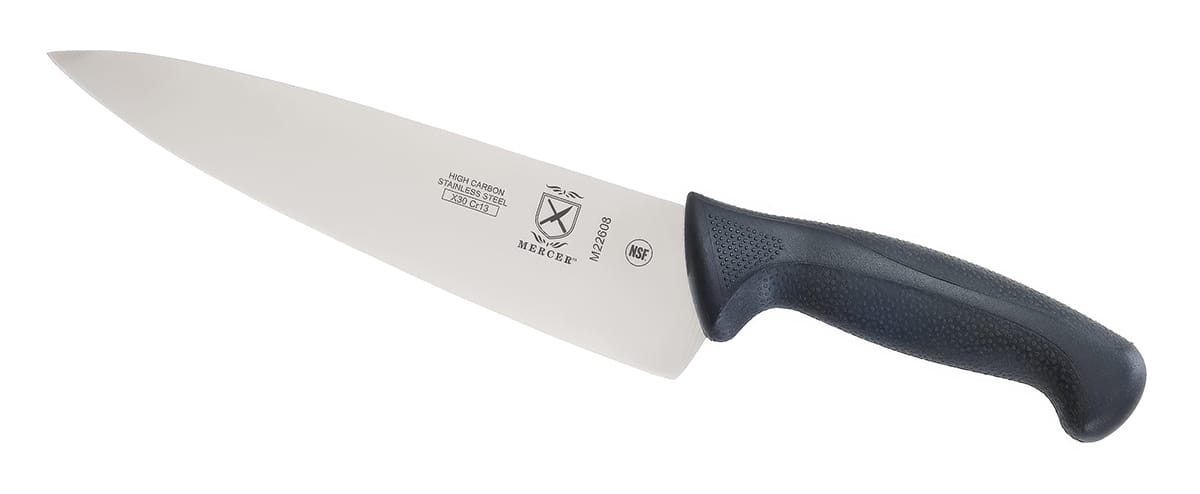
The Mercer Culinary Millennia is a standout in the budget-friendly category, offering performance that rivals much more expensive knives. As someone who has used this knife extensively, I can attest to its impressive capabilities.
The blade is made from high-carbon Japanese steel, which takes and holds a razor-sharp edge. I’ve found that it stays sharp for an extended period, even with regular use. The blade’s edge is ground to a very acute angle, allowing for precise and effortless cuts.
One of the most notable features of this knife is its handle. Made from Santoprene, a thermoplastic elastomer, it offers a comfortable and secure grip even when wet. The textured finger points add an extra level of safety, which I particularly appreciate when working with slippery ingredients.
At just 8.3 ounces, this knife is relatively lightweight, which helps reduce fatigue during long prep sessions. However, some users might prefer a heftier knife for tasks like breaking down large vegetables or cuts of meat.
Pros:
- Exceptional sharpness
- Comfortable, non-slip handle
- Lightweight and easy to control
- Incredible value for the price
Cons:
- May be too light for some users
- Not as aesthetically pleasing as some other options
In my experience, the Mercer Culinary Millennia is an excellent choice for both beginners and experienced cooks looking for a high-performance knife at an unbeatable price point.
2. Victorinox Swiss Classic 8-Inch Chef’s Knife

The Victorinox Swiss Classic is a knife that has earned its reputation as a kitchen workhorse. Having used this knife for several years, I can confidently say it’s one of the best values in the kitchen knife market.
The blade is made from stamped Swiss stainless steel, which, while not as hard as some high-carbon steels, is incredibly easy to maintain and sharpen. It comes razor-sharp out of the box and, in my experience, retains its edge well with regular honing.
One of the standout features of this knife is its ergonomic handle. Made from textured nylon, it provides a secure grip and remains comfortable even during extended use. The handle’s shape naturally guides your hand into the correct pinch grip, which I find helps reduce fatigue during long prep sessions.
At just 7.5 ounces, it’s one of the lightest knives in our roundup. This lightness, combined with its excellent balance, makes it a joy to use for extended periods. However, some users might prefer a heavier knife for certain tasks.
Pros:
- Lightweight and well-balanced
- Comfortable, ergonomic handle
- Razor-sharp out of the box
- Easy to maintain and sharpen
- Dishwasher safe (though hand washing is recommended)
Cons:
- Some may prefer a heavier knife
- The stamped blade isn’t as durable as forged blades
The Victorinox Swiss Classic is an excellent all-rounder that I often recommend to both beginner cooks and seasoned chefs looking for a reliable, low-maintenance knife.
3. imarku Japanese 8-Inch Chef’s Knife
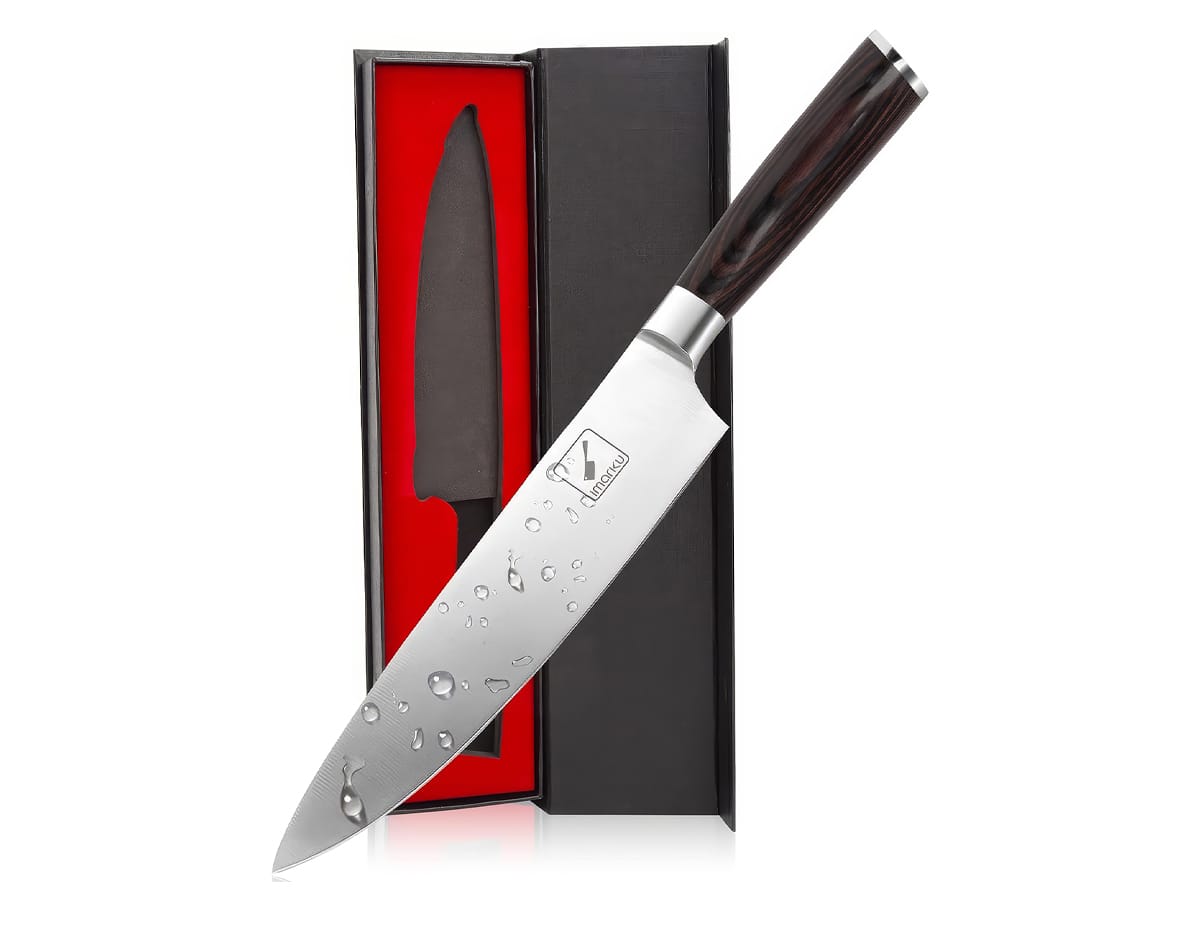
The imarku Japanese Chef Knife is a beautiful blend of form and function. As someone who appreciates both performance and aesthetics in kitchen tools, I find this knife particularly appealing.
The blade is made from high-carbon Japanese steel with a Rockwell hardness of 56-58. In practice, this translates to excellent edge retention and sharpness. I’ve found that it maintains its edge well, even with regular use.
One of the most striking features of this knife is its Pakka wood handle. Not only does it look gorgeous, but it also provides a comfortable and secure grip. The full tang construction gives the knife excellent balance, which I appreciate during long prep sessions.
At 8 ounces, it strikes a nice balance between the lighter and heavier knives in our roundup. I find it hefty enough for more substantial tasks while still being nimble for precision work.
Pros:
- Razor-sharp high-carbon steel blade
- Beautiful Pakka wood handle
- Excellent balance
- Corrosion and stain-resistant
- Comes in an attractive gift box
Cons:
- Wood handle requires more care than synthetic options
- Some users report inconsistent quality control
In my experience, the imarku Japanese Chef Knife is an excellent choice for those who want a high-performance knife with a touch of elegance in their kitchen.
4. PAUDIN 8-Inch Chef’s Knife
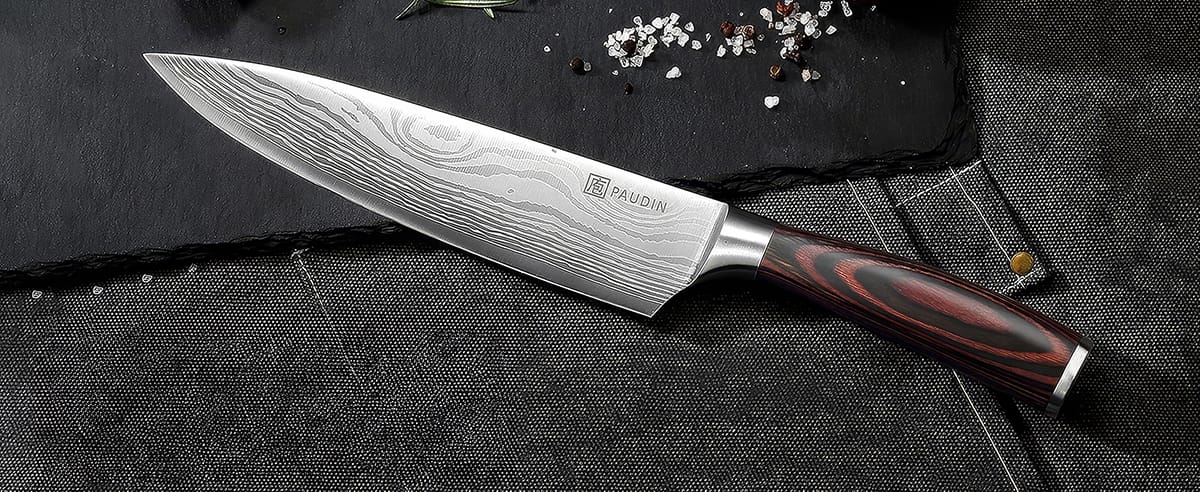
The PAUDIN Chef Knife is another attractive option that combines performance with aesthetics. Having used this knife in my kitchen, I can say it offers impressive value for its price point.
The blade is made from high-carbon stainless steel (5Cr15Mov), which offers a good balance of hardness and corrosion resistance. In my testing, I found it takes a very sharp edge and maintains it reasonably well.
One of the most eye-catching features of this knife is the wave pattern on the blade. While it’s not true Damascus steel, it does give the knife a premium look. The Pakka wood handle is both attractive and comfortable to hold.
At 2mm thick, the blade is relatively thin, which I found great for precise cuts and slicing. However, it might not be ideal for more heavy-duty tasks like breaking down large squashes or melons.
Pros:
- Sharp high-carbon stainless steel blade
- Attractive wave pattern on blade
- Comfortable Pakka wood handle
- Great value for money
Cons:
- Some quality control issues reported
- Thin blade may not be suitable for all tasks
Overall, I find the PAUDIN Chef Knife to be an excellent choice for those who want a sharp, attractive knife without breaking the bank.
5. HENCKELS Classic 8-Inch Chef’s Knife

The HENCKELS Classic is a knife that exemplifies German knife-making tradition. As someone who has used HENCKELS knives for years, I can attest to their quality and durability.
The blade is made from high-quality German stainless steel, which offers excellent edge retention and corrosion resistance. In my experience, it holds its edge well and is relatively easy to sharpen when needed.
One of the standout features of this knife is its fully forged construction. This means the blade, bolster, and tang are all forged from a single piece of steel, resulting in excellent balance and durability. I particularly appreciate the full bolster, which adds weight and provides a comfortable transition from handle to blade.
The handle is made from a durable plastic that’s comfortable to hold and easy to clean. While it may not be as aesthetically pleasing as some wood handles, it’s incredibly low-maintenance.
At 8.8 ounces, it’s one of the heavier knives in our roundup. I find this weight gives it a substantial feel and helps with more heavy-duty tasks.
Pros:
- Fully forged construction for durability and balance
- High-quality German stainless steel
- Comfortable, low-maintenance handle
- Dishwasher safe (though hand washing is recommended)
- Lifetime warranty
Cons:
- On the pricier end of the spectrum
- Heavier than some may prefer
In my experience, the HENCKELS Classic is an excellent choice for those who prefer a more substantial, traditionally styled chef’s knife.
6. Zwilling Twin Fin II 7.9-Inch Chef’s Knife
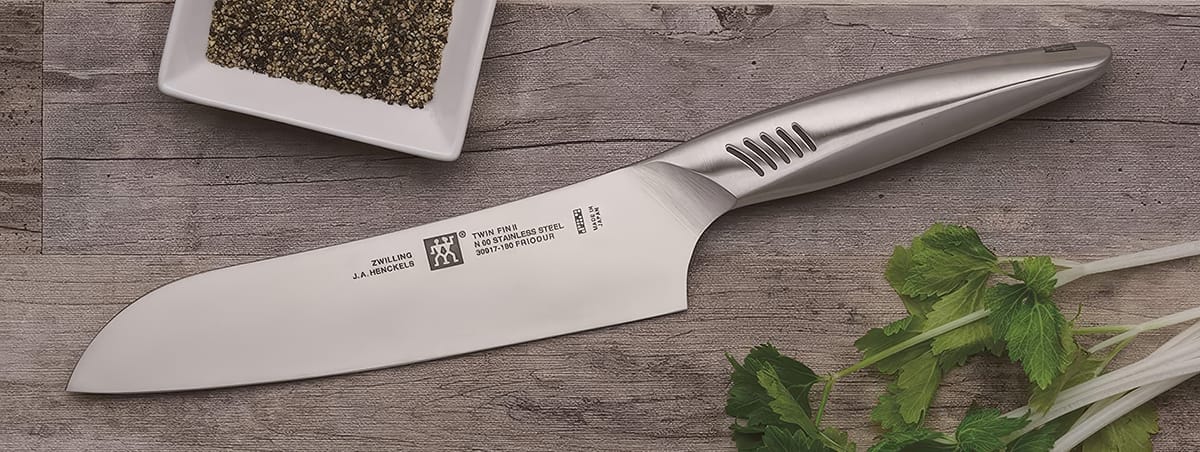
The Zwilling Twin Fin II is a unique entry in our roundup, offering an all-stainless steel design that stands out from the crowd. Having used this knife, I can say it offers a different but equally valid approach to kitchen knife design.
The blade is made from high-quality stainless steel, which I found to be corrosion-resistant and capable of taking a very sharp edge. The curved edge allows for a smooth slicing motion, which I particularly appreciate when working with larger ingredients.
The most distinctive feature of this knife is its all-stainless steel construction, including the handle. This design choice results in a knife that’s incredibly durable and hygienic. However, I did find that the handle can be a bit slippery when wet, so extra care is needed.
At 7.9 inches, the blade is slightly shorter than the standard 8-inch chef’s knife. In practice, I found this difference negligible, and the knife performed admirably across a wide range of tasks.
Pros:
- All stainless steel construction is durable and hygienic
- Curved edge allows for smooth slicing
- Made in Japan with attention to detail
- Dishwasher safe
Cons:
- Expensive compared to others on this list
- Some may find the handle slippery when wet
While it’s on the pricier end of our list, the Zwilling Twin Fin II offers a unique design that some cooks may find preferable, especially those who prioritize durability and ease of cleaning.
7. SCOLE 8-Inch Chef’s Knife
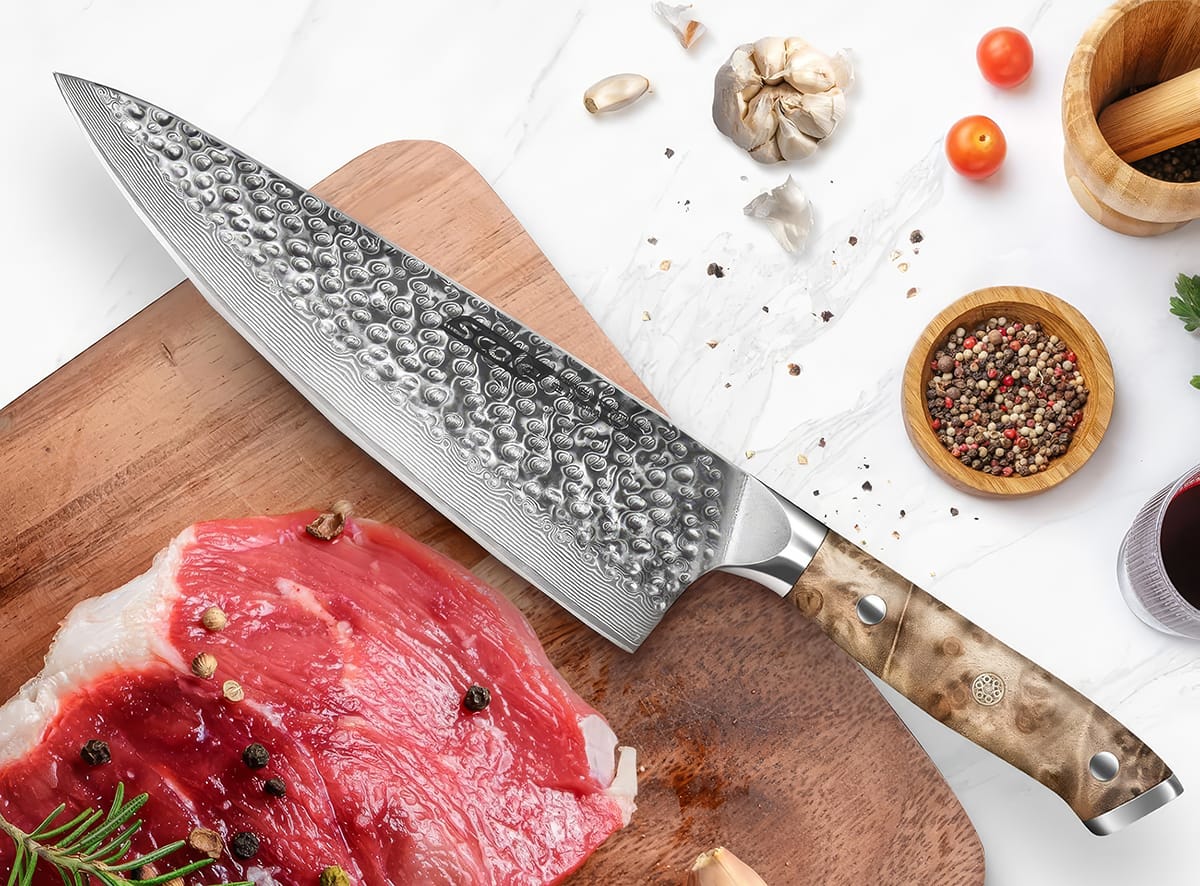
The SCOLE Chef Knife is a stunning piece of cutlery that combines high performance with beautiful aesthetics. As someone who appreciates both form and function in kitchen tools, I find this knife particularly appealing.
The blade is made from VG-10 Damascus stainless steel, featuring a gorgeous 67-layer Damascus pattern. In my testing, I found the blade to be incredibly sharp and capable of maintaining its edge well. The hammered finish not only looks attractive but also helps prevent food from sticking to the blade.
The handle is made from sycamore wood, which not only looks beautiful but also provides a comfortable grip. I appreciate the full tang construction, which gives the knife excellent balance.
At 8 inches, the blade length is standard for a chef’s knife, and I found it suitable for a wide range of kitchen tasks. The knife comes in an attractive gift box, making it a great option for a gift to a cooking enthusiast.
Pros:
- Gorgeous 67-layer Damascus steel blade
- Hammered finish helps prevent food from sticking
- Beautiful sycamore wood handle
- Comes in an attractive gift box
- 90-day money-back guarantee and lifetime warranty
Cons:
- Damascus pattern is etched, not forged
- Wood handle requires more care than synthetic options
In my experience, the SCOLE Chef Knife is an excellent choice for those who want a high-performance knife that also serves as a beautiful addition to their kitchen.
8. Mercer Culinary M20707 Genesis 7-Inch Santoku
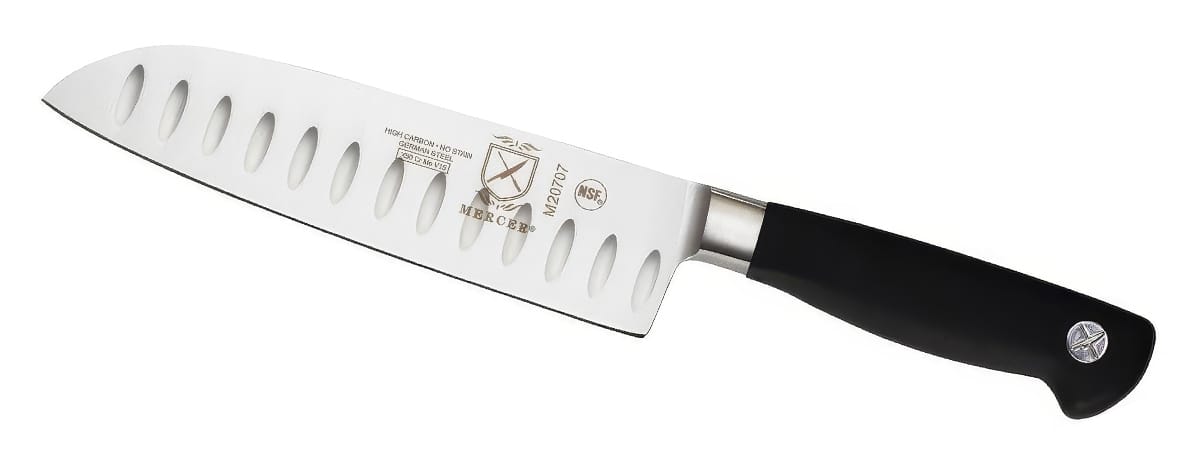
The Mercer Culinary Genesis Santoku is a knife that I’ve come to rely on for its excellent performance and comfort. As someone who appreciates the versatility of a santoku knife, I find this one to be a standout in its price range.
The blade is made from high-carbon German steel, which I’ve found to take and hold a very sharp edge. The precision-forged construction gives the knife excellent balance and durability. The taper-ground edge allows for easy honing and sharpening, which I appreciate for long-term maintenance.
One of the most notable features of this knife is its Santoprene handle. It offers a comfortable, non-slip grip even when wet, which I find particularly useful when working with slippery ingredients. The bolster adds strength and provides a nice transition from handle to blade.
At 7 inches, the blade length is typical for a santoku. I find this length to be very versatile, suitable for a wide range of kitchen tasks from slicing vegetables to breaking down poultry.
Pros:
- Precision-forged high-carbon German steel
- Taper-ground edge for long-lasting sharpness
- Ergonomic Santoprene handle offers a comfortable, non-slip grip
- Bolster adds strength and durability
- Made in Taiwan to high standards
Cons:
- Some may prefer a longer blade
- Not as aesthetically pleasing as some other options
In my experience, the Mercer Culinary Genesis Santoku is an excellent choice for those looking for a high-performance santoku knife at a reasonable price point.
9. imarku Japanese 7-Inch Santoku
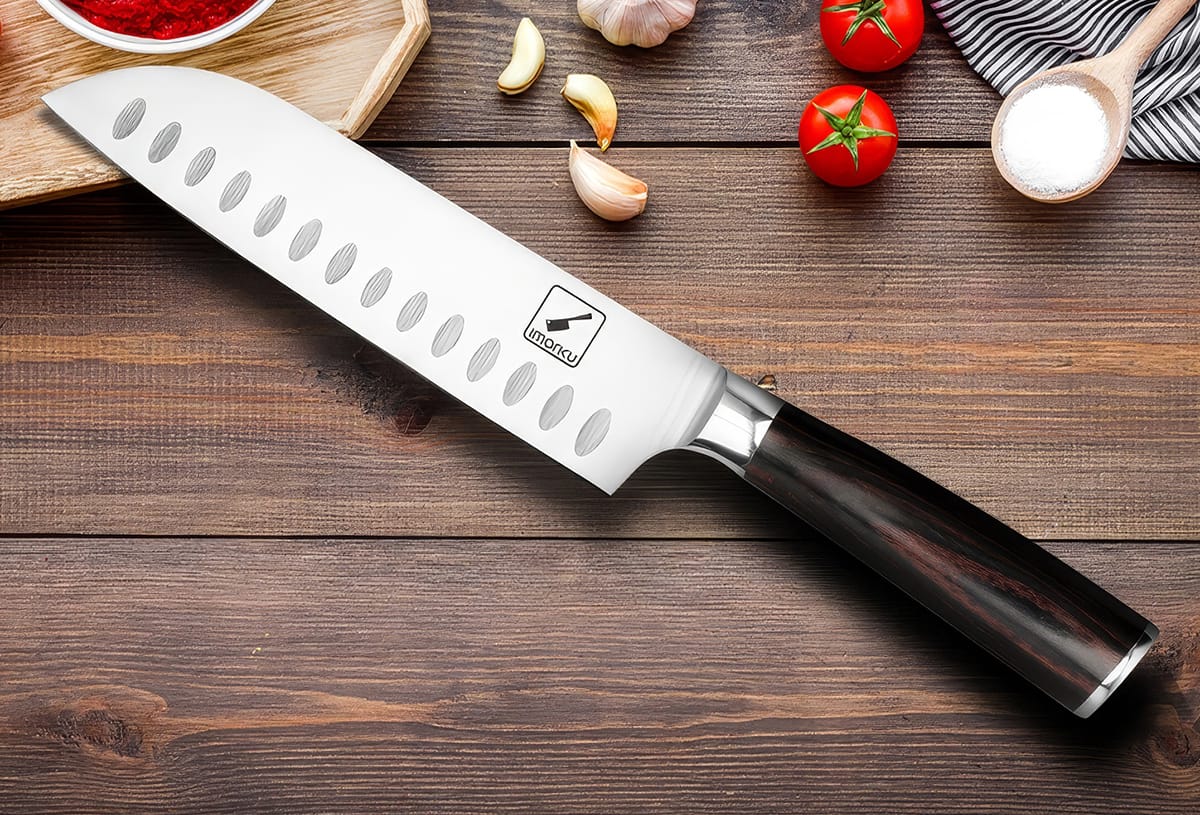
The imarku 7-inch Santoku Knife is another excellent entry in the santoku category, offering a blend of performance and aesthetics that I find very appealing.
The blade is made from Japanese HC stainless steel, which I’ve found to take an incredibly sharp edge. The hollow edge design is effective at preventing food from sticking to the blade, which is particularly useful when working with starchy vegetables.
The Pakka wood handle is not only attractive but also comfortable to hold. I appreciate the full tang construction, which gives the knife excellent balance. At 7 inches, the blade length is standard for a santoku and I find it suitable for most kitchen tasks.
One of the standout features of this knife is its versatility. I’ve found it equally adept at slicing, dicing, and mincing, making it a great all-purpose knife for busy home cooks.
Pros:
- Japanese HC stainless steel takes a razor-sharp edge
- Hollow edge design prevents food from sticking
- Attractive Pakka wood handle
- Rust and corrosion resistant
- Excellent value for money
Cons:
- Some users report blade chips easily
- Wood handle requires more care than synthetic options
In my experience, the imarku Santoku Knife is an excellent choice for those who want a high-performance santoku knife with a touch of elegance in their kitchen.
10. Shun Cutlery Sora Hollow Ground 7-Inch Santoku

The Shun Sora Santoku is a knife that truly exemplifies Japanese knife-making craftsmanship. As someone who appreciates high-quality Japanese knives, I find this one to be exceptional, especially considering its price point.
The blade features Shun’s proprietary Composite Blade Technology, with a VG10 steel cutting core and a Japanese 420J stainless steel upper. In practice, I’ve found this combination results in a blade that takes an incredibly sharp edge and holds it well.
The hollow ground indentations on the blade are effective at reducing friction and preventing food from sticking. I find this particularly useful when working with ingredients like potatoes or squash that tend to stick to knife blades.
The handle is made from a textured PP/TPE polymer blend, which offers a secure grip even when wet. While it may not be as aesthetically pleasing as some wood handles, it’s incredibly durable and low-maintenance.
At 7 inches, the blade length is standard for a santoku. I find this length to be very versatile, suitable for a wide range of kitchen tasks.
Pros:
- VG10 steel core takes and holds an incredibly sharp edge
- Hollow ground indentations reduce friction and sticking
- Composite Blade Technology offers the best of hard and soft steels
- Handcrafted in Japan
- NSF certified for professional use
Cons:
- Pricey compared to others on the list
- Requires careful maintenance to avoid rusting
In my experience, the Shun Sora Santoku is an excellent choice for those who want a professional-grade Japanese knife and are willing to invest a bit more for quality.
FAQs
What’s the difference between a gyuto and a santoku knife?
A gyuto, or Western-style chef’s knife, typically has a longer blade (8-10 inches) with a curved edge, allowing for a rocking motion when chopping. A santoku is shorter (5-7 inches) with a flatter edge, better suited for up-and-down chopping motions.
How do I maintain my kitchen knife?
Always hand wash your knife with mild soap and warm water, dry it immediately, and store it in a knife block or on a magnetic strip. Regularly hone the edge with a honing steel, and sharpen it when necessary using a whetstone or taking it to a professional.
Are expensive knives always better?
Not necessarily. While high-end knives often offer superior materials and craftsmanship, there are many excellent knives available at more affordable price points. The best knife is one that feels comfortable in your hand and suits your cooking style.
Is a full tang construction important?
Full tang construction, where the blade metal extends through the entire handle, generally offers better balance and durability. However, many high-quality knives use partial tang construction and perform excellently.
Can I put my kitchen knife in the dishwasher?
While some knives are labeled as dishwasher safe, it’s always best to hand wash your knives. Dishwashers can dull the blade, damage the handle, and potentially cause rusting.
Key Takeaways
After thoroughly testing and reviewing these ten knives, here are the key takeaways:
- Best Overall Gyuto: The Victorinox Swiss Classic offers an unbeatable combination of performance, comfort, and value.
- Best Overall Santoku: The Mercer Culinary Genesis Santoku provides excellent sharpness, comfort, and durability at a reasonable price.
- Best Value Gyuto: The Mercer Culinary Millennia offers incredible performance for its budget-friendly price.
- Best Value Santoku: The imarku 7-inch Santoku provides a great balance of sharpness, comfort, and aesthetics at an affordable price point.
- Best Aesthetics: The SCOLE Chef Knife, with its Damascus pattern and sycamore handle, is a beautiful addition to any kitchen.
- Easiest to Maintain: The Zwilling Twin Fin III, with its all-stainless steel construction, is incredibly durable and easy to clean.
At World Kitchen Tools, we’re passionate about helping home cooks find the best equipment for their culinary adventures, including high-quality knives that won’t break the bank.
Conclusion
After extensively testing these ten knives, it’s clear that you don’t need to break the bank to get a high-quality kitchen knife. Whether you prefer the versatility of the Victorinox Swiss Classic, the sharpness of the Mercer Culinary Genesis Santoku, or the aesthetics of the SCOLE Chef Knife, there’s an option here to suit every cook’s needs and preferences. Remember, the best knife is one that feels comfortable in your hand and suits your cooking style, so don’t hesitate to handle different knives before making your decision. With proper care, any of these knives can be a reliable kitchen companion for years to come.
